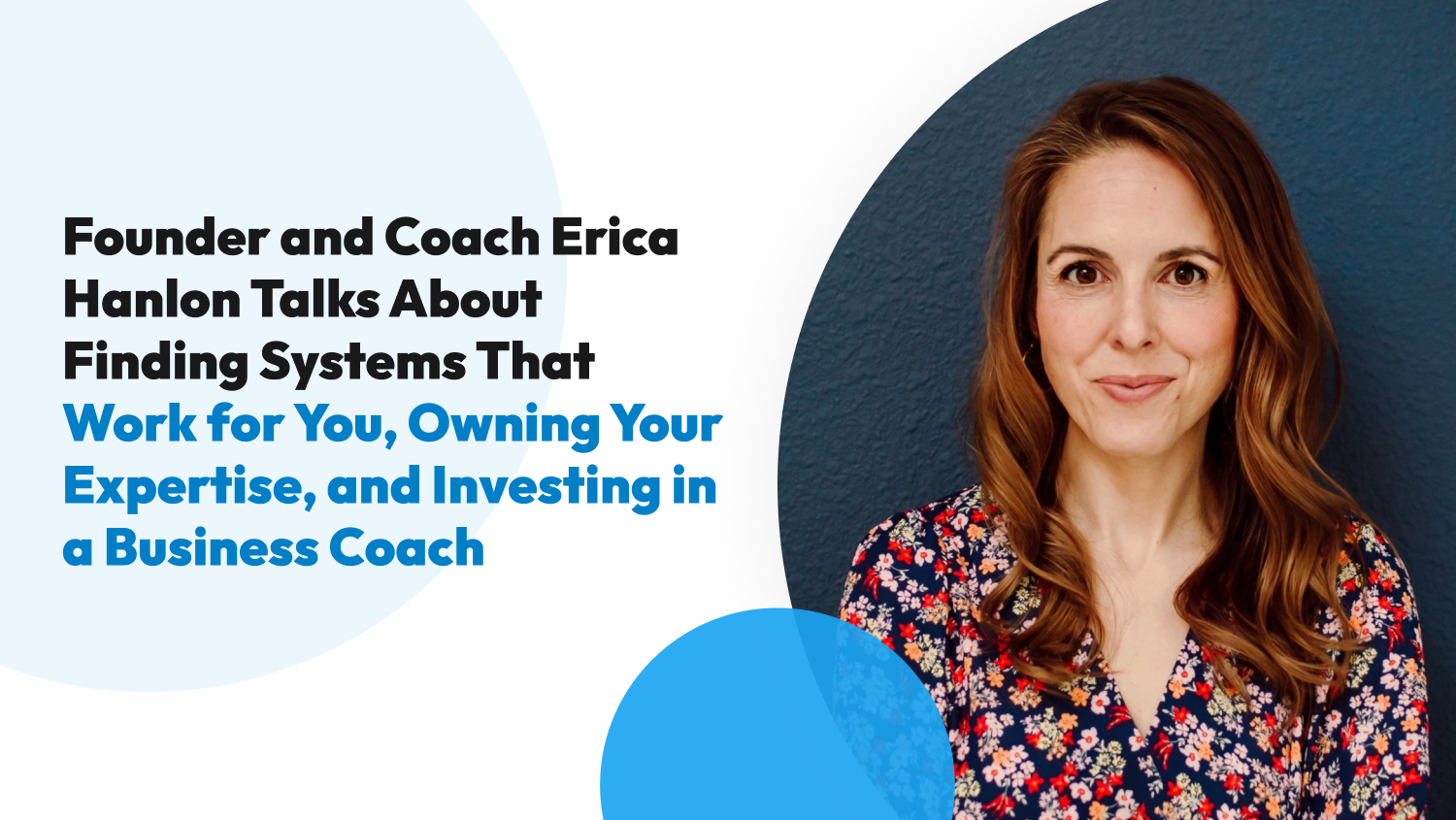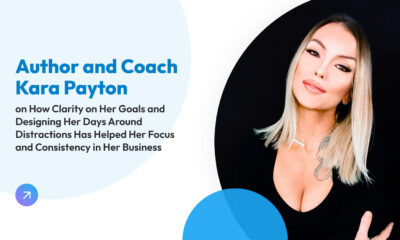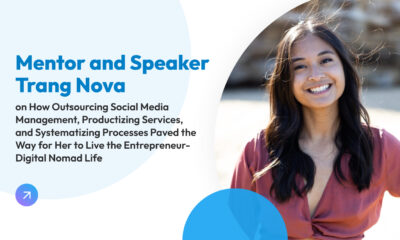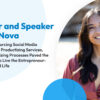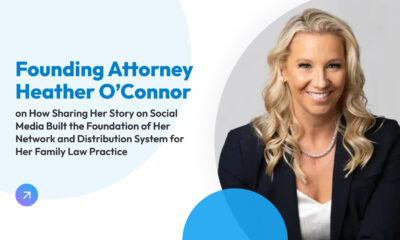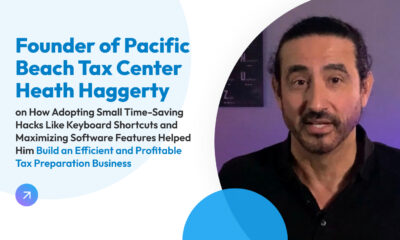Case Study
Founder and Coach Erica Hanlon Talks About Finding Systems That Work for You, Owning Your Expertise, and Investing in a Business Coach
Erica Hanlon spent 17 years moving from one extreme of the career spectrum to the other – from a burnt-out therapist to a bored corporate consultant and trainer. In spite of not really believing she was built to be an entrepreneur, she decided the best way out of her career crisis was to start a business of her own.
In this article, we learn about Hanlon’s growth from a confused and unsure ‘corporate dropout’ to a thriving life and business coach. Don’t forget to check out the end with her Reading List and Productivity Stack Quick Reference!
Table of Contents
- Starting
- Growing
- Scaling and Success
- Other recommend tools
- Hindsight: What Hanlon would have done earlier
- Wrap Up
- Hanlon’s Productivity Stack Quick Reference
- Hanlon’s Read List
- More About Hanlon
Starting
Challenge 1: Going into the unknown – Leaving her corporate job
Hanlon went straight to clinical therapy work after completing her master’s degree in Clinical Psychology. She worked a tough job as a clinician at a youth corrections institution and burned out after about three years.
She decided to try a corporate job, consulting and providing training on employee performance and corporate wellness initiatives. It all looked good on paper, but she was bored and unfulfilled.
She recalls, “I started asking myself really important questions, like, ‘What is it that I do like about my job?’ ‘How do I turn that into a career?’” She enjoyed the one-on-one interactions with people at the end of her training sessions, and this was how her business idea came to her. She decided to coach high-achieving, type-A individuals who felt lost and confused, much like herself.
Going into business was a big challenge because she always thought she would be a career employee. Entrepreneurship was not something that came naturally to her, or so she thought. Even as a kid, she didn’t join the Girl Scouts because she didn’t want to sell cookies!
But her frustration with her job was stronger motivation than her aversion to the idea of selling. So she set out a plan to make this shift less daunting, especially financially. She thought, “How do I make that work in a way where I don’t feel like I’m at risk of living in a cardboard box under a bridge?”
Solution: She set some metrics for when she could leave her full-time job with some sense of financial security: 1) having six months of income saved or 2) having a certain number of clients that she couldn’t handle with a full-time job.
About one year and three months after she made this decision, she had enough clients to make the leap. She hit her target right in the middle of the COVID lockdowns and uncertainty of 2020.
“My hands were shaking like crazy. I thought I was going to spill coffee all over myself right before I got on the call with my supervisor to tell her I was leaving. It was so scary. And then I did it, and it was amazing!”
People: Hanlon
Systems: Setting herself a realistic ‘runway,’ starting her business on a part-time basis until it got to a sustainable level
Tools: Phone to call her supervisor to resign
Challenge 2: Distribution: How she got her first clients
She started the business while still working full-time in 2019. She admits building her client base took some time, especially in the first six months. She used social media but found it took longer to convert than speaking to prospects face to face.
Solution: Hanlon describes herself as a “very socially awkward person.” Mingling or talking to people was not in her comfort zone. Nevertheless, she took advantage of all the networking opportunities to get in front of people to tell them what she did. She went to every party, and every happy hour she was invited. She even gave free training at a library about stress management.
It was purely from social events that she found her first clients. But she points out that for both formal networking events and parties or happy hours, it took two, three, or even six months to convert any new leads. “There was never immediate gratification from any of those events. Well, except for one party where a woman signed up right on the spot. She said, ‘You’re a life coach; I need to hire a life coach.’ That did happen one time.”
Today, she also uses social media (Instagram, Pinterest, and her website) for lead generation. She also gets plenty of business from referrals from existing and old clients.
People: Hanlon
Systems: Networking
Tools: Phone, Google Calendar, Pinterest, Instagram, Squarespace
Growing
Challenge 3: Delegation: Hiring support staff
Because her business is simple, Hanlon does her own bookkeeping with an Excel spreadsheet. She did hire an accountant right from the start, though, because she “doesn’t speak taxes.”
She saw the need to hire a second person to help in the business when she noticed Pinterest was working very well as a lead generation tool. “I really hated making pins on Pinterest. But this platform really works for me. How can I just outsource that?”
Solution: Hanlon found a Pinterest specialist through a referral. They hit it off immediately, and she didn’t even look for more candidates. It worked out very well because one and a half years later, her metrics show that her Pinterest strategy continues to bring in a good number of leads.
People: Hanlon, Pinterest specialist
Systems: Referrals or recommendations from contacts
Tools: Excel, LinkedIn, Pinterest
Challenge 4: Streamlining appointment-setting
In the beginning, Hanlon tried to use very basic tools for taking appointments. She had a form on her website and used Google Calendar and her email. Clients or prospects would fill out the form, and there was a lot of back and forth over email to finalize a schedule.
She tells us, “I was losing people during that exchange about when they could get on my calendar.”
Solution: She finally got Calendly. The client or prospect setting their own appointments based on availability in the Calendar took away all the manual emailing. “It’s just so much easier. It’s so much simpler to do it that way.”
People: Hanlon
Systems: Automating a process
Tools: Google Calendar, Squarespace, Gmail, Calendly
Challenge 5: Streamlining client note-taking and record-keeping
Other basic but critical elements in Hanlon’s processes are note-taking for sessions and record-keeping for her clients.
Coming from her therapist background, she used to write all her notes on paper and keep them in physical folders. She decided to upgrade when she realized how much she struggled to retrieve and review notes. “You have to dig through the paper to find your notes.”
She tried Rocketbook, which combines a reusable writing surface with cloud storage. You take a photo of your handwritten notes on the erasable notebook using their app, upload it to online storage and then physically erase the notebook pages so you can restart note-taking again. However, she soon grew tired of the cumbersome process too. She says, “It was great for a while, except that I hated the whole process of taking the picture and uploading it and wiping the notebook down.”
Solution: She invested in reMarkable, a digital notebook that can directly transfer pages of notes to cloud storage. This tool eliminates the step of taking photos and wiping down the notebook. It also allows her to share screen on Zoom with clients during sessions, send copies of the notes through email, and save notes to clients’ respective Google drives.
People: Hanlon
Systems: Investing in the tool that improves your business processes
Tools: reMarkable, Google Drive
Challenge 6: Adjusting her offer to meet client needs
Since starting her business, Hanlon’s focus has been on one-to-one coaching. Until recently, she sold coaching session packages in three and six-month bundles. The frequency of sessions was fixed to weekly, but she found out this didn’t work for all clients. Some found weekly sessions too frequent or too far apart.
She tells us, “Some people were like, ‘That’s too much for me. I cannot meet every week.’ They didn’t feel like they had enough time to integrate whatever action plans we were putting together.”
Solution: She decided to revise her packages to 12 or 24 sessions, which the client can use at the pace they prefer. “I realized people have different rhythms, so I decided it’s better to just give a number of sessions, and we can meet at a frequency that really works for the client.”
People: Hanlon
Systems: Listening to client feedback and revising her services and offers to address their concerns
Tools: Google Calendar, reMarkable, Google Drive, Zoom, Calendly
Challenge 7: Time management with an unpredictable schedule
With coaching sessions now on an ‘irregular’ schedule based on client needs, how does she manage her time? Not just for other business-related tasks but for family life and running the household with three kids?
Solution: Hanlon maximizes Calendly’s functions to limit the number of calls in a day or week and work hours within the day. She has also learned to stick with her boundaries in meeting with people.
She shares with us, “I have ADHD, inattentive type, so I don’t do well with most systems. So for me, it’s really about understanding and recognizing sort of my own natural rhythms, where I tend to be most productive, where I tend to waste a lot of time.”
Among some of the systems that work for her are batching content production and repurposing content. She is also more productive in the mornings and has to end her work hours by 5 PM.
She used to reserve Mondays as a client call-free day, but it turned out counterproductive for her. She recalls, “When I had a day open, I always filled it with doctor’s or dentist’s appointments, or I would just find myself wandering around my house thinking, ‘What am I even doing today?’ I just felt sort of untethered, not having client calls. Doing at least one client call a day turns on the business part of my brain and puts me in work mode.”
She also realized that a lot of her pending tasks were actually just decisions that had to be made. Her tendency to overthink, to the point of wondering how many exclamation points are appropriate to use in a message, took up a lot of her time.
To manage this, she sets a time limit or deadline for all her decision-making. “If I’m like, ‘Oh, I don’t know what I’m going to post.’ You know what, [I] set a timer for 15 minutes and just put it out there. Even if it’s trash, it’s better than nothing.”
People: Hanlon
Systems: Capping work hours and the number of calls she takes in a day, testing and looking for a work pattern that increases productivity, setting time limits on decision-making, batching content production, and repurposing content
Tools: Google Calendar, Calendly, Phone timer
Scaling and Success
Challenge 8: How to reach more people
Hanlon knows there are a lot more people who could benefit from coaching, but the cost of one-to-one sessions is a barrier. At the same time, she knows there is a market for high-level one-to-one coaching that also needs to be served.
Solution: Hanlon plans to continue providing one-to-one coaching services for a limited number of clients. But she is also working on adding group coaching programs. She tells us, “I think at some point this year, what I’d like to do is probably launch something more like a membership-type program. There will be a group call once a week so that I can reach more people at more price points.”
She currently has one coaching group, even though it isn’t a regular format for her business yet. She brought together several clients facing similar issues in marketing their businesses. This experience and seeing how her peers are able to reach a wider audience with group coaching has encouraged her to expand into this format, as well.
People: Hanlon
Systems: Identifying and responding to a market need
Tools: Google Calendar, Squarespace, Calendly, Zoom
Other recommend tools
Hanlon gave us a few other tools that are critical for her business:
- Separate Google account, Gmail, Google Calendar, Google Drive for business and personal use
- Dropbox Sign for handling contracts
- PayPal for invoicing
Hindsight: What Hanlon would have done earlier
Hanlon shares two things she wished she would have done earlier.
The first was, “I would have owned my expertise a lot faster.” She spent a lot of time doubting her abilities, waiting for external validation, and being unsure about what value she could bring to a client. Of course, this lack of clarity and confidence reflected in how she marketed herself.
She now knows, “I don’t have to be the top coach in my industry. I don’t have to feel 100% confident. I don’t need so many clients to get amazing results and tell me how great I am. I just need to be confident that I can help somebody and then just go out there and do that.”
The second thing she would have done earlier was to hire a business coach. When she started her business part-time in 2019, she joined a group coaching program. She was able to make about $10,000 in sales around nine months after completing that program.
Hanlon then invested all of the $10,000 she earned in one-on-one coaching with Samantha Siffring. She says, “I paid her every dime I had made [from the previous coaching program]. And then I had my first five-figure month right after that. There’s definitely a direct correlation between me, hiring my coach, and my business growing really, really fast. I don’t think that that’s a coincidence that I invested in the same product I was selling.” She continues to work with this coach today.
Wrap Up
Hanlon overcame a lot of preconceived notions and limiting beliefs to transform into the entrepreneur and coach she is today. She started out disliking sales with a passion, being socially awkward, and even struggling to work within systems because of ADHD. But signing up for coaching helped with her mindset, and in just over two years, she grew her part-time coaching practice into a six-figure business.
She is mindful of working with her natural rhythm to maximize productivity, and she honors this same need of her clients to go at the pace that works best for them. Her approach towards building her routines and systems reminds us that these are highly individual- each one of us has to find what works for us. Even her business name, business model, and tools are kept simple so she can avoid overthinking and analysis paralysis.
We wish her all the best as she expands to the group coaching format this year. Her coaching expertise, backed by her own experiences and growth as an entrepreneur, will definitely be an excellent resource for individuals pursuing big goals and striving for positive change in their lives.
Hanlon’s Productivity Stack Quick Reference
Starting
Growing
Scaling and Success
Hanlon’s Read List
- Big Magic by Elizabeth Gilbert
- Atomic Habits by James Clear for understanding how the mind works around goal-setting and how to achieve them
- The Gap and the Gain: The High Achievers’ Guide to Happiness, Confidence, and Success by Dan Sullivan for going after big goals
More About Hanlon
Erica is a licensed therapist, career coach, and life coach. She went from working as a psychotherapist in a prison, burning out and then becoming a management consultant and corporate wellness trainer, to now having a successful, multiple-six-figure life coaching business.
She helps her clients make a big impact in their life and career. Her ideal clients are those who know they want to do big things but still enjoy life while accomplishing them. They struggle with anxiety, doubt, insecurity, and feeling like they’re not good enough even though, on the outside, everything looks “perfect.”
Find out more and get in touch:
Website: https://www.ericahanlon.com/
Instagram: https://www.instagram.com/ericahanloncoaching/


